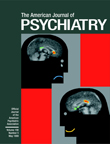To the Editor: Irwin Feinberg, M.D., criticizes our article for not providing a more complete set of references that highlight “Darwinian” competition in sustaining connectivity between neurons. This discussion was beyond the scope of our article, but we thank him for recalling the large number of workers who have studied trophic factors and neural competition.
Dr. Feinberg describes the limitations of the Huttenlocher postmortem study of prefrontal synaptic density
(1). We agree that the number of data points in that study referable to adolescence was limited. However, a recent study in monkeys demonstrated downward shifts in prefrontal connectivity associated with pubescence
(2), thereby providing further reason to believe that downward shifts in prefrontal synaptic density occur during human adolescence. Dr. Feinberg complains that we did not cite his prior article
(3), where he noted that reductions in cerebral metabolism and synaptic elimination occur in parallel during the course of adolescent neurodevelopment. Dr. Feinberg deserves credit for first proposing a functional relationship between these two sets of observations. We raised this issue in order to suggest that curtailed cortical metabolism in schizophrenia, which has been observed in many studies, could arise directly from reductions in neuropil and synapses.
Dr. Feinberg criticizes our synaptic elimination model of hallucinated “voices” as being too simple. Our computer simulation was composed of only 148 neuronal elements, and its ability to generate “hallucinations” was limited to one word that emerged in response to external inputs. We were the first to acknowledge these limitations. A more comprehensive model of hallucinated speech would incorporate verbal working memory with more complex linguistic expectations involving whole phrases and sentences that could be triggered by both verbal thought and external speech. Such models would require much more extensive vocabularies and many more neuronal elements. Nonetheless, we feel that our model in its current form has merit insofar as it generates a number of testable predictions regarding neuroanatomic and neurocognitive abnormalities in schizophrenic patients reporting “voices.”
As an alternative explanation, Dr. Feinberg proposes that positive symptoms in schizophrenia arise from the failure of mechanisms that distinguish self-generated from externally stimulated neuronal activity. He suggests that disruptions of corollary discharge cause these reality-testing failures. Corollary discharge refers to representations of motor action sequences such as visual saccades, which, when executed, alter sensory inputs and therefore require correction by feed-forward adjustments. To the best of our knowledge, there has been only one study directly exploring a linkage between corollary discharge, monitoring failures, and schizophrenia, and it produced a negative result
(4).
Also relevant is a comparison of brain activation in hallucinating and nonhallucinating subjects during verbal imagery exercises
(5). Regional activation was similar except when subjects imagined hearing speech spoken by others. Under these conditions, hallucinating subjects demonstrated reduced activation of the supplementary motor area and left middle temporal lobe. The authors suggested that these brain activation failures “might contribute to a less secure appreciation” of the actual source of verbal images. However, there are no studies specifically linking failed cortical activation to difficulties in identifying the source of thoughts/images. Therefore, a faulty-monitoring hypothesis to account for hallucinated speech requires additional study. Our alternative hypothesis is that these hallucinations are deviant outputs of a pathologically altered working memory system underlying speech perception. A recently completed study of speech perception and verbal working memory comparing hallucinating and nonhallucinating subjects supports this hypothesis (unpublished 1998 study of Hoffman et al.).

